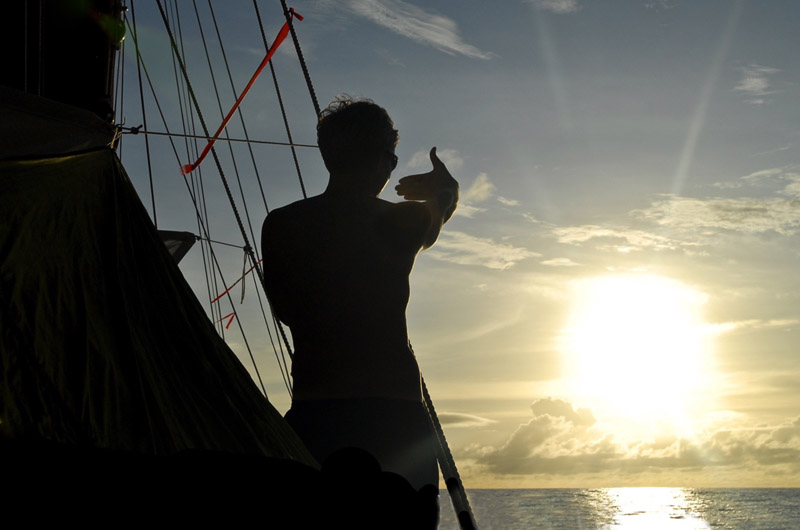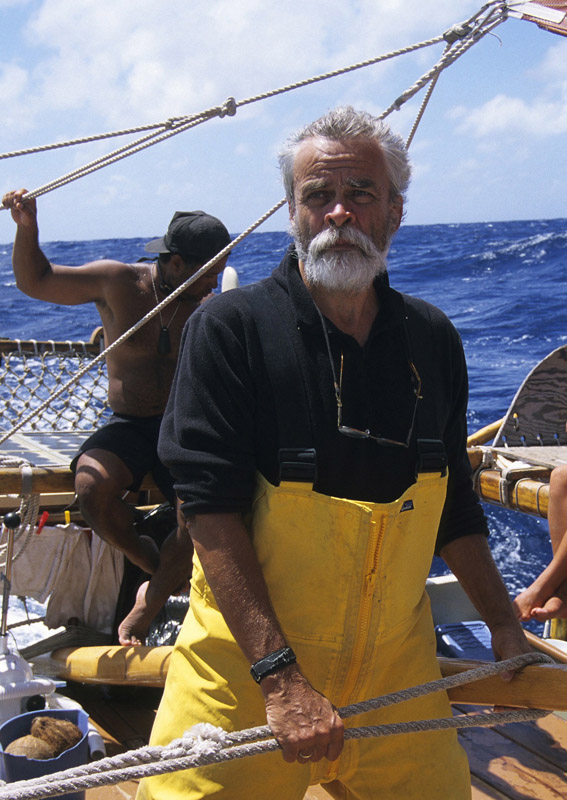On Feb. 26, 2000, we departed Tahiti, bound for the big Island of Hawaii. As we sailed beyond the reef and into the deep ocean, the sea turned azure, then almost black. On shore, the people of Tautira village waved farewell against a backdrop of palm trees and nestled houses. I imagined a similar scene, a thousand years ago, when my ancestors set out on voyages of exploration to the furthest reaches of the Polynesian triangle.
We set our sails to the southeast trade winds and our vessel, Hokule’a, accelerated. She is a 62-foot double-hulled canoe, essentially a catamaran, a design that evolved over thousands of years of trial and error by Polynesian seafarers who voyaged this vast Pacific Ocean. None of these ancient vessels survive today — Hokule’a is a replica, as close to her ancestral predecessors as rigorous study can produce.
As a young boy, I had read Kon-Tiki, Thor Heyerdahl’s account of his 1947 voyage from Peru deep into Polynesian waters aboard a balsa raft. For 101 days, Heyerdahl and his crew floated haplessly across an immense ocean to finally crash on a reef in the Tuamotus. With this voyage, he claimed to prove that Polynesia was settled from South America by mariners who drifted into the Pacific with the prevailing winds and currents.
But Heyerdahl was wrong. Research has showed that Polynesians came from the opposite direction, from Island Southeast Asia, forcing their way against the powerful winds and currents to Tonga, Fiji and Samoa, arriving at about the time Troy was falling to the Greeks. They sailed onward, eventually populating all of Polynesia a thousand years or so after Christ was born. And they voyaged in sleek seaworthy vessels like Hokule’a.
Most of us on board for this voyage were of mixed blood, part Hawaiian, part something else. I am three-quarters New England Yankee and a quarter Hawaiian. My father grew up among the high volcanic peaks of the big island — the Kohalas, Hualailai and Mauna Kea. When he was 17, he was sent away to school in New England. He married and settled down. He found solace in the waters off Martha’s Vineyard, fishing every day from a Hubert Johnson sea-skiff called Dollop. I remember him singing songs in broken Hawaiian, visits from Hawaiian relatives who danced the hula in our living room, his stories of surfing mountainous swells. He made plans to return to his birthplace, but events always seemed to intervene. In 1964, when I was preparing to travel to Pearl Harbor to begin a hitch in the Navy, he took me aside. “Now that you will be there, I am finally going to return. I will see you in Hawaii soon,” he said. He died that night.
I deployed aboard a U.S. Navy ship as the Viet Nam war was beginning. Returning to Pearl Harbor, I found that Hawaiian culture was in steep decline. The native Hawaiian population had been decimated by disease. Their lands had been taken from them, their language had almost disappeared, their pride seemed broken. During the years that followed, my life took many turns — but Hawaii always seemed to linger in my soul. I became a filmmaker and eventually produced a documentary in 1982 about Polynesian voyaging — The Navigators, Pathfinders of the Pacific. To make the film, I spent two years, with experienced archeologists as guides, retracing the steps taken by early Polynesian voyagers. I sailed with Mau Piailug, one of the last traditional navigators, from his home island of Satawal in the Carolines. He told me how he navigated without charts or instruments by the stars and by signs in the wind and waves that were part of a lore handed down from father to son over thousands of years. I spent time in Hawaii with my cousin, Nainoa Thompson, who is navigator on this voyage. He combined Mau’s teachings with his own discoveries to reveal how ancient Polynesians may have guided their canoes. Over the years, Nainoa sailed to New Zealand, Samoa, the Cook Islands and Rapa Nui (Easter Island) — following in the wake of the first Polynesian explorers. At the same time, a swelling native rights movement, spawned among Hawaii’s First People, merged with the struggle of black Americans and washed over Hawaii. Hawaiians discovered what they had lost — and why. From deep in the aina — the earth — came a surging cultural rebirth. Hula and chant, ancient arts that carried the lore of famous navigators and wise chiefs, seemed to rise out of the ground, secrets preserved by the elders. Ancient temples were rebuilt, the healing arts flourished, language immersion programs spawned a new generation of Hawaiian speakers. And Hokule’a sailed on, helping to spark this Hawaiian renaissance, affirming with each voyage that Polynesians were truly among the world’s greatest seafarers.
Every day, as we voyaged north from Tahiti, I walked to Hokule’a’s bow at sunset. From inside my windbreaker I took a small glass vial and uncorked it, pouring a few drops of its contents into the ocean. These were waters taken from the ocean just off Cape Pogue where we had buried the ashes of my father. With this simple ritual, I invited his spirit to join me.
Through a steady band of trade winds, across the equator and its squalls and dead air, and on into the belt of northeast winds, Nainoa guided Hokule’a by a combination of Mau Piailug’s teachings and his own observations of the sky and sea. He steered the canoe by signs in the shape of constellations, the curl of ocean swells, the flight of birds, the winds. On the 23rd day out of Tahtiti, he ordered us to steer directly west. Except for catnaps, Nainoa had been on watch the entire voyage — staring out into what seemed an empty ocean. Now, having observed signs invisible to the rest of us, he was certain that Hawaii lay directly ahead. Running with the wind, we felt only a hint of breeze from astern. Mist wafted over the canoe, seemed to stall in a thin veil ahead of us. All day we continued on toward this gossamer cloud which parted and formed again behind us.
“The mist to the north and south continues to move,” Nainoa told me, ”but in front it seems to hit something and stall. It sits there like a constant fog. That makes me think there’s land there.”
There was also the wind. For a time it held steady from astern, and we sailed wing-on-wing, then it shifted southeast making it hard to fill our sails without changing course. For those of us manning the sweeps it was an annoyance. For Nainoa, it was another land sign.
“The trade winds cannot rise over the high slopes of Mauna Loa so when they encounter the volcano they split to flow around it. One branch blows southwest down the Puna coast, the other flows southeast along the Hamakua coast. The wind was originally from the east. When it veered southeasterly, it was an indication we are north of Hilo.”
None of us had seen these signs. We did not doubt they existed, but to predict his position within a few miles after a 2,400-mile voyage seemed impossible. We tacked the canoe to starboard to follow a map that existed only in Nainoa’s mind. The Hamakua Coast, if it was there, was invisible in the darkening mist. Slowly, by a latent instinct, we all became aware that something large lay to port. We could feel it — a kind of pressure of some sort. We joined at the port rail, and peered into the darkness.
Then we saw a hairline crack in the clouds. A few minutes later, the twinkling lights of Hilo appeared on our beam. As the clouds continued to lift, tiny lights sprinkled the coastline — the glimmer of the small town of Honoka’a.
Speaking for all of us, Nainoa said simply, “We’re home.”
On this Columbus day, author Sam Low recalls a voyage to celebrate an earlier seafaring people who explored and settled one third of Earth’s surface long before Columbus set out. The above is adapted from his book, Hawaiki Rising — Hokule’a, Nainoa Thompson and the Hawaiian Renaissance.
At this writing, Hokule’a and Nainoa Thompson are approaching the coast of South Africa on a voyage around the world. After a winter stop in Cape Town, Hokule’a will cross the Atlantic and arrive in Miami in March 2016. She will continue up the coast to Cape Canaveral, Savannah, Charleston, Beaufort, Newport News, Washington, D.C., Annapolis, New York city, Mystic, Newport, Martha’s Vineyard (in early July) and Boston — before setting out across the Atlantic to Lisbon and ports in the Mediterranean.
To learn more about her voyage, visit www.Hokulea.com.









Comments (10)
Comments
Comment policy »